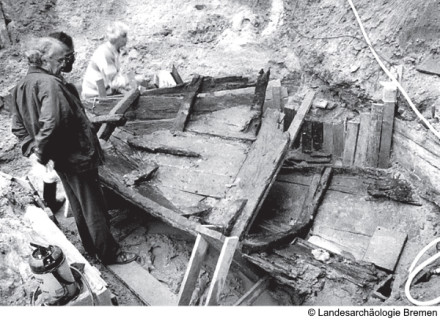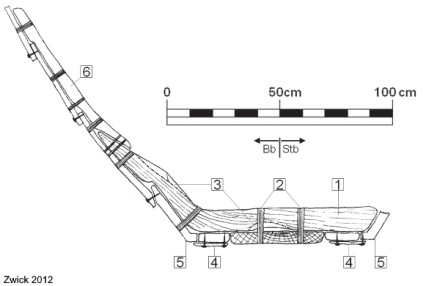History
Wreck beneath a brewery
During excavation works on the premises of the Beck's Brewery In Bremen, Germany in 1989, a bow-section of a wooden river barge was discovered at a distance of 150 metres from the present river embankment. The wreck was located on a gravel bank in what had been a tributary of the Weser River called the Balge.

The excavation documents (unpublished) reveal that the wreck must have changed its position on the river bed, as is indicated by the altered stratigraphy inside the wreck, as well as the coarseness of the sediments, indicating a high-energy current that must have existed at the time of the sinking. The local geologist Dr. Dieter Ortlam reconstructed the medieval river course on the basis of core samples and the distribution of shipwrecks.

Description
The bow section measures 3.7 metres in length. At the time of discovery a single sample from a plank was dated by dendrochronology to 1489. Another sample was taken from the keel-plank in 2009 and revealed an earlier date of 1444. Thus the plank may indicate a later repair. Indeed, the wreck features signs of repairs: the stem rabbet was re-cut to insert a new scantling, indicating that the hood-ends must have come loose.
The vessel was platform based, i.e. the bottom was built with very wide, tangentially sawn flush-laid planks, whereas the side planks were joined in the lapstrake fashion. Half-frames (asymmetric floor timbers) [no. 1] and futtocks [no. 6]) were added in an alternating fashion.

Barely worked compass timber was used for the frames with plenty of sapwood inclusions [no. 3]. Only the connecting surfaces were levelled off. This wreck features an L-shaped chine [no. 5], a feature known also in river barges from the Rhine area since Roman times. In Bremen, this particular feature was also observed in the Karl wreck of 808 and thus marks 650 years of local continuity. It has also been observed in high and late medieval wrecks in the Vistula river.
Status
The wreck fragment was salvaged and conserved, and is exhibited in the Focke Museum (Bremen's municipal history and art museum).
References
- Focke Museum.
- Ortlam, D. (1996).
Das mittelalterliche Flusssystem der Weser im Bremer Becken. Die Balge als Hauptstrom der Werra/Weser.
Der Aufbau 51.
pp 28-32. - Rech, M. (2004).
Gefundene Vergangenheit. Archäologie des Mittelalters in Bremen (= Bremer Archäologische Blätter, Beiheft 3.
Bremen. - Zwick, D. (2012).
Variationen in der mittelalterlichen Schiffbautechnik anhand von Wrackfunden in Bremen.
Holzbau in Mittelalter und Neuzeit (= Mitteilungen der Deutschen Gesellschaft für Archäologie des Mittelalters und der Neuzeit 24).
pp 283-298.